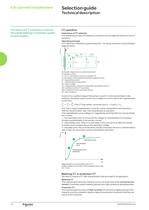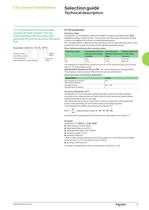
Catalog excerpts

Medium Voltage Distribution Indoor instrument Current transformers Voltage transformers Make the most of your energy
Open the catalog to page 1
Indoor instrument General contents LPCT: Electronic current
Open the catalog to page 3
Instrument transformers COïltGïltS
Open the catalog to page 5
Instrument transformers Presentation The Schneider Electric range of instrument transformers is designed for voltages from 0.72 kVto 36 kV and rated currents from In order to meet requirements for increasingly high short circuit current values in installations, current transformers notably have a short-time thermal current All Schneider Electric instrument transformers are in conformity with IEC ■ Current transformers can specifically relative to recommendations concerning transformer behaviour during transient short circuit conditions concerning enhanced safety electrical equipment for...
Open the catalog to page 6
Instrument transformers Presentation Quality is the result of scheduling and monitoring at each stage, from initial design through to production and testing, and right through to final delivery and after sales This is expressed in terms of execution in conformity with the quality certification. This procedure allows us to supply a product that has all of the specified characteristics and also to provide the customer with a production and execution schedule that guarantees product quality. Certified quality system Schneider Electric's quality guarantee is certified in documents that are...
Open the catalog to page 7
instrument transformers Applications and types Protection or metering devices have to receive data on electrical values (current or voltage) from the equipment to be protected. Fortechnical, economic and safety reasons, this data cannot be obtained directly on the equipment's MV power supply; we have to use intermediary These devices carry out the functions of: ■ Reducing the size of value to be ■ Providing galvanic separation ■ Supplying the power needed to process the data, or even for the protection device Metering transformer applications In MV electrical distribution, the high current...
Open the catalog to page 8
CTs: Current Transformers COïltGïltS Using the order forms 16 DIN standard 12 kVCT- single and double secondary 17 DIN standard 24 kV CT - single secondary 18 DIN standard 24 kV CT - double secondary 19 24 kV primary conductor support CT - single secondary 20 24 kV primary conductor support CT - double secondary 21 36 kV primary conductor support CT - single secondary 22 36 kV primary conductor support CT - double secondary 23 17.5 - 24 - 36 kV split-over CT - single and double secondary 24 0.72 kV closed core CT - single and double secondary 25
Open the catalog to page 9
Selection guide Technical description Current transformers (CT) meet standard Their function is to supply the secondary circuit with a current that is proportional to that of the MV circuit on which they are the MV network and subject to the same over-currents as the latter and withstands terminals connected to earth. The secondary must never be in an open circuit (short circuit). Magnetic core Wound type primary current Magnetic core Closed core type current Current transformers Current transformers have two basic functions: ■ adapting the MV current value at the primary to the...
Open the catalog to page 10
Selection guide Technical description Characteristics (cont.) Short-time thermal current peak value This value is standardized from Ith -1 s at: Accuracy load The value of the load on which is based the metered current accuracy conditions. Apparent power (VA) that the CT can supply on the secondary for the rated secondary current for which the accuracy is guaranteed (accuracy load). Accuracy class Defines the limits of error guaranteed on the transformation ratio and on the phase shift under the specified conditions of power and current. Classes 0.5 and 1 are used for metering class P for...
Open the catalog to page 11
Selection guide Technical description The choice of CT is decisive in order for the overall metering or protection system The operating accuracy of metering or protection devices depends directly on the CT Operating principle A CT often has a load that is quite resistive (Rc + its wiring), as shown in the schematic diagram below. Schematic diagram fora current transformer 12 = Kn 11: secondary current for a perfect CT. Is: secondary current actually flowing through the circuit. E: induced electromotive force. Lm: magnetization inductance (saturable) equivalent to the CT. Rwir: resistance of...
Open the catalog to page 12
Selection guide Technical description We can define the over-current coefficient of the CT: The lower Ksi, the easier the CT is to produce with a given volume, compatible with being integrated in a MV cubicle. A high Ksi leads to over-dimensioning of the CT and makes it difficult to produce. The CT secondary is used at low impedance (virtually in short circuit). The secondary circuit should never be left open, since this would mean connecting across an infinite impedance. Under these conditions, hazardous voltages for personnel and equipment may exist across the terminals. Terminal marking...
Open the catalog to page 13
Selection guide Technical description CT's for metering must have the right accuracy for the rated current. They are characterized by their accuracy class (generally 0.5 or 1) as well as a safety Primary current Secondary current Accuracy power - Accuracy class according to application Error limits according to the accuracy class Accuracy class A metering CT is designed to send as accurate an image as possible of currents below 120% of the rated primary. I EC standard 60044-1 determines the maximum error in the accuracy class for the phase and for the module according to the indicated...
Open the catalog to page 14
Selection guide Technical description CT's for protection must have suitable accuracy for fault currents. They are characterized by their accuracy class (generally 5P) and the accuracy limit factor Primary current Secondary current Accuracy power - Accuracy class A protection CT is designed to send as reliable an image as possible of the fault current (overload or short circuit). The accuracy and the power are suited to these currents and different from those for metering applications. EC standard 60044-1 determines the maximum error for each accuracy class in the phase and in the module...
Open the catalog to page 15All Schneider Electric catalogs and technical brochures
-
CFT34A
2 Pages
-
IMT30A
2 Pages
-
15607
2 Pages
-
IMV25
2 Pages
-
Evolis 24kV catalogue
80 Pages
-
NEX 24 catalogue 2010
56 Pages
-
Fuses catalogue 2012
24 Pages
-
RM6 Catalogue
76 Pages
-
Catalogue Human Machine Interfaces
150 Pages
-
Osiswitch XCK_N catalogue
16 Pages
-
Catalogue Osisense XG
26 Pages





























